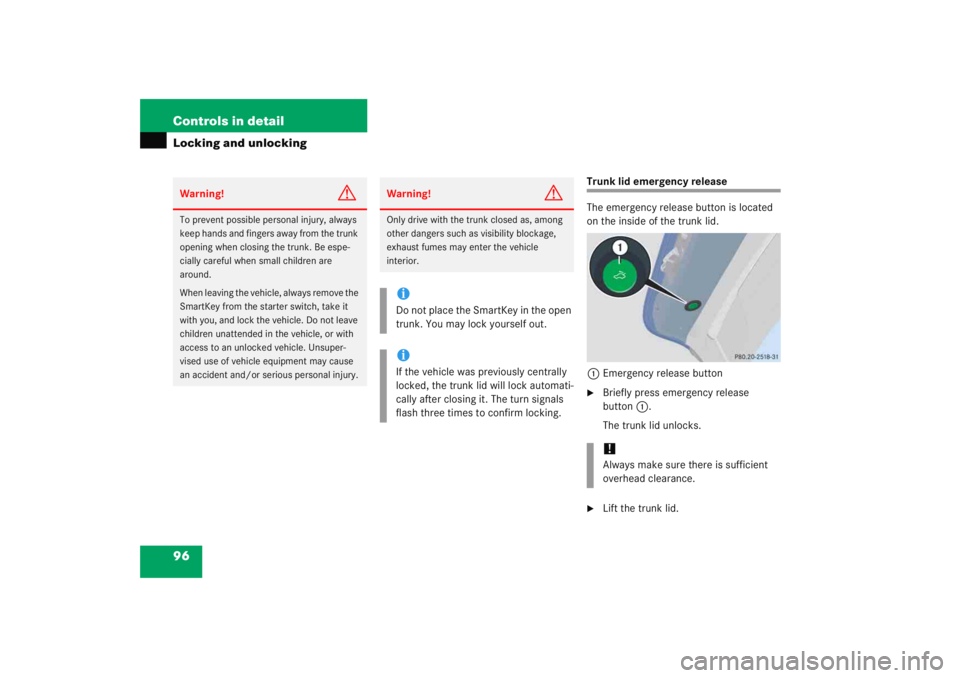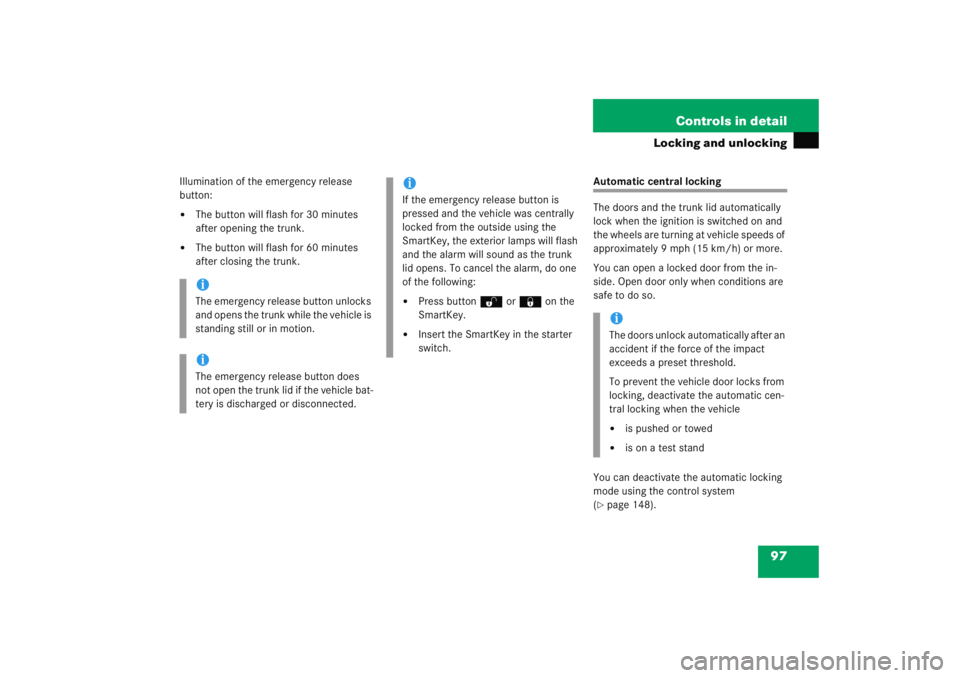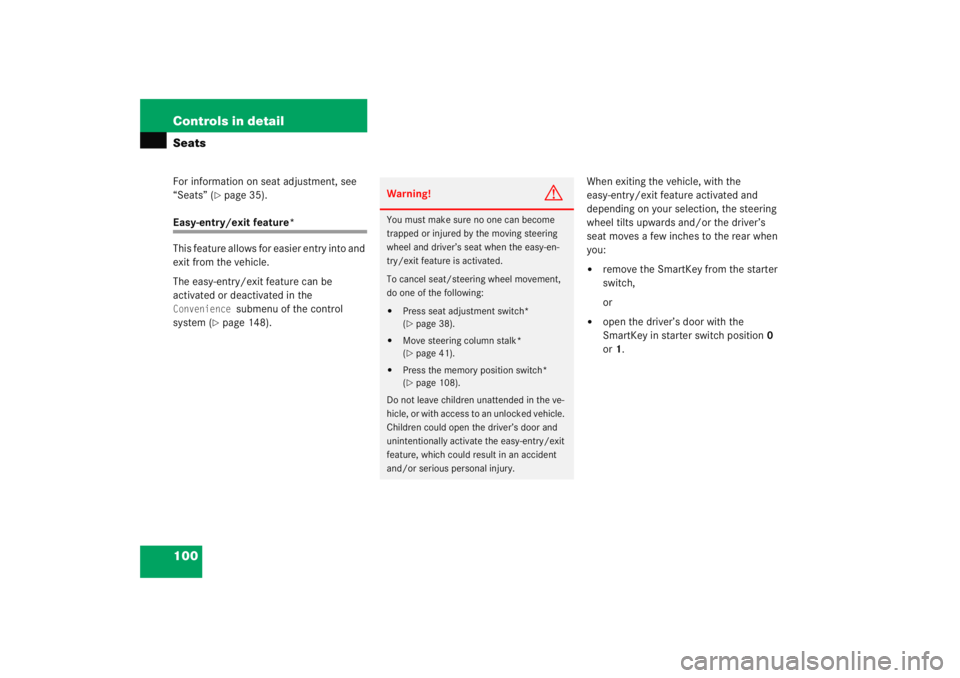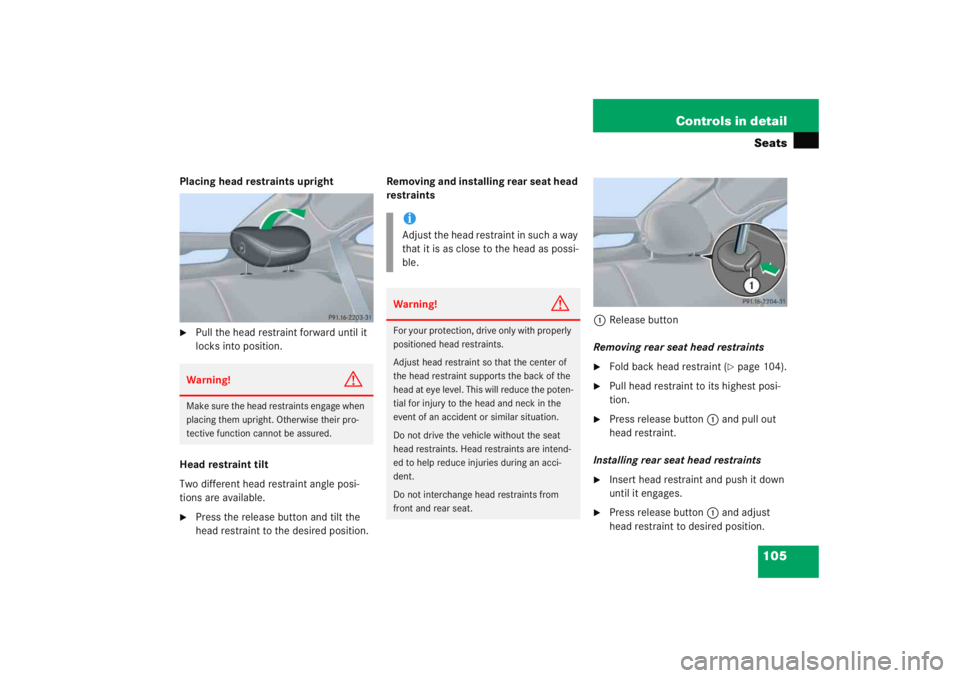Page 95 of 474
94 Controls in detailLocking and unlockingLoss of SmartKey or mechanical key
If you lose a SmartKey or mechanical key,
you should do the following:�
Have the SmartKey deactivated by an
authorized Mercedes-Benz Center.
�
Report the loss of the SmartKey or the
mechanical key immediately to your
car insurance company.
�
If necessary, have the mechanical lock
replaced.
An authorized Mercedes-Benz Center will
be glad to supply you with a replacement.
Opening the doors from the inside
You can open a locked door from the in-
side. Open door only when conditions are
safe to do so.
1 Locking knob
2 Inside door handle�
Pull on door handle 2.
If door was locked, locking knob 1 will
move up.
iIf the vehicle has previously been
locked from the outside with the
SmartKey, opening a door from the in-
side will trigger the alarm.
To cancel the alarm, do one of the fol-
lowing:�
Press button Œ or‹ on the
SmartKey.
�
Insert the SmartKey in the starter
switch.
Page 96 of 474
95
Controls in detail
Locking and unlocking
Opening the trunk lid
A minimum height clearance of 7.1 ft.
(2.16 m) is required to open the trunk lid.
The handle is located above the rear li-
cense plate recess.
1 Handle The vehicle must be unlocked.
�
Pull on handle
1.
The trunk lid unlocks.
�
Lift the trunk lid.
The trunk can also be opened from its in-
side in an emergency, see “Trunk lid emer-
gency release” (
�page 96).
Closing the trunk lid
1 Handle�
Lower trunk lid by pulling firmly on
grip 1.
�
Close trunk lid with hands placed flat
on the trunk lid.
!Always make sure there is sufficient
overhead clearance.
Page 97 of 474

96 Controls in detailLocking and unlocking
Trunk lid emergency release
The emergency release button is located
on the inside of the trunk lid.1 Emergency release button�
Briefly press emergency release
button 1.
The trunk lid unlocks.
�
Lift the trunk lid.
Warning!
G
To prevent possible personal injury, always
keep hands and fingers away from the trunk
opening when closing the trunk. Be espe-
cially careful when small children are
around.
When leaving the vehicle, always remove the
SmartKey from the starter switch, take it
with you, and lock the vehicle. Do not leave
children unattended in the vehicle, or with
access to an unlocked vehicle. Unsuper-
vised use of vehicle equipment may cause
an accident and/or serious personal injury.
Warning!
G
Only drive with the trunk closed as, among
other dangers such as visibility blockage,
exhaust fumes may enter the vehicle
interior.iDo not place the SmartKey in the open
trunk. You may lock yourself out.iIf the vehicle was previously centrally
locked, the trunk lid will lock automati-
cally after closing it. The turn signals
flash three times to confirm locking.
!Always make sure there is sufficient
overhead clearance.
Page 98 of 474

97
Controls in detail
Locking and unlocking
Illumination of the emergency release
button:�
The button will flash for 30 minutes
after opening the trunk.
�
The button will flash for 60 minutes
after closing the trunk.
Automatic central locking
The doors and the trunk lid automatically
lock when the ignition is switched on and
the wheels are turning at vehicle speeds of
approximately 9 mph (15 km/h) or more.
You can open a locked door from the in-
side. Open door only when conditions are
safe to do so.
You can deactivate the automatic locking
mode using the control system
(�page 148).
iThe emergency release button unlocks
and opens the trunk while the vehicle is
standing still or in motion.iThe emergency release button does
not open the trunk lid if the vehicle bat-
tery is discharged or disconnected.
iIf the emergency release button is
pressed and the vehicle was centrally
locked from the outside using the
SmartKey, the exterior lamps will flash
and the alarm will sound as the trunk
lid opens. To cancel the alarm, do one
of the following:�
Press button
Œ or‹ on the
SmartKey.
�
Insert the SmartKey in the starter
switch.
iThe doors unlock automatically after an
accident if the force of the impact
exceeds a preset threshold.
To prevent the vehicle door locks from
locking, deactivate the automatic cen-
tral locking when the vehicle�
is pushed or towed
�
is on a test stand
Page 99 of 474
98 Controls in detailLocking and unlockingLocking and unlocking from the inside
You can lock or unlock the doors and the
trunk lid from inside using the central lock-
ing switch. This can be useful, for example,
if you want to lock the vehicle before start-
ing to drive.
You cannot lock or unlock the fuel filler flap
with the central locking switch.Depending on production date, your
vehicle is equipped with either switch de-
sign A or B.
The switches are located in the center
console.
Switch design A1
Central locking switch
2 Central unlocking switch
Switch design B1Central locking switch
2 Central unlocking switch
Warning!
G
When leaving the vehicle, always remove the
SmartKey from the starter switch, take it
with you, and lock the vehicle. Do not leave
children unattended in the vehicle, or with
access to an unlocked vehicle. Unsuper-
vised use of vehicle equipment may cause
an accident and/or serious personal injury.
Page 100 of 474
99
Controls in detail
Locking and unlocking
Locking�
Press central locking switch
1.
If all doors are closed, the vehicle
locks.
Unlocking
�
Press central unlocking switch 2.
The vehicle unlocks.
iYou can open a locked door from the
inside. Open door only when conditions
are safe to do so.
If the vehicle was previously centrally
locked using the SmartKey, it will not
unlock using the central unlocking
switch 2.
If the vehicle was previously locked
with the central locking switch 1�
while in the selective remote con-
trol mode, only the door opened
from the inside is unlocked.
�
while in the global remote control
mode, the vehicle is unlocked
completely when a door is opened
from the inside.
Page 101 of 474

100 Controls in detailSeatsFor information on seat adjustment, see
“Seats” (
�page 35).
Easy-entry/exit feature*
This feature allows for easier entry into and
exit from the vehicle.
The easy-entry/exit feature can be
activated or deactivated in the Convenience
submenu of the control
system (
�page 148). When exiting the vehicle, with the
easy-entry/exit feature activated and
depending on your selection, the steering
wheel tilts upwards and/or the driver’s
seat moves a few inches to the rear when
you:
�
remove the SmartKey from the starter
switch,
or
�
open the driver’s door with the
SmartKey in starter switch position
0
or 1.
Warning!
G
You must make sure no one can become
trapped or injured by the moving steering
wheel and driver’s seat when the easy-en-
try/exit feature is activated.
To cancel seat/steering wheel movement,
do one of the following:�
Press seat adjustment switch*
(�page 38).
�
Move steering column stalk*
(�page 41).
�
Press the memory position switch*
(�page 108).
Do not leave children unattended in the ve-
hicle, or with access to an unlocked vehicle.
Children could open the driver’s door and
unintentionally activate the easy-entry/exit
feature, which could result in an accident
and/or serious personal injury.
Page 106 of 474

105
Controls in detailSeats
Placing head restraints upright�
Pull the head restraint forward until it
locks into position.
Head restraint tilt
Two different head restraint angle posi-
tions are available.
�
Press the release button and tilt the
head restraint to the desired position. Removing and installing rear seat head
restraints
1Release button
Removing rear seat head restraints
�
Fold back head restraint (
�page 104).
�
Pull head restraint to its highest posi-
tion.
�
Press release button 1 and pull out
head restraint.
Installing rear seat head restraints
�
Insert head restraint and push it down
until it engages.
�
Press release button 1 and adjust
head restraint to desired position.
Warning!
G
Make sure the head restraints engage when
placing them upright. Otherwise their pro-
tective function cannot be assured.
iAdjust the head restraint in such a way
that it is as close to the head as possi-
ble.Warning!
G
For your protection, drive only with properly
positioned head restraints.
Adjust head restraint so that the center of
the head restraint supports the back of the
head at eye level. This will reduce the poten-
tial for injury to the head and neck in the
event of an accident or similar situation.
Do not drive the vehicle without the seat
head restraints. Head restraints are intend-
ed to help reduce injuries during an acci-
dent.
Do not interchange head restraints from
front and rear seat.